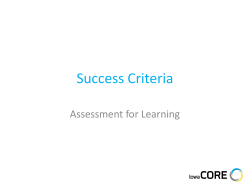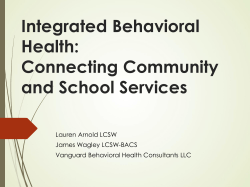
Reimagining Children's Mental Health Services
Welcome! Today’s Webinar on “Reimagining Children’s Services” will begin shortly… Keep in mind: • Everyone is currently muted. • Use the chat box to submit questions or comments to the presenter. Choose send to “All Panelists” in the dropdown. • If you are having technical issues, send a message via chat to the “Host” or email alcantara@nyu.edu. • The webinar recording and formal responses to questions will be posted on www.ctacny.com. Donna Bradbury, MA, LMHC Associate Commissioner Division of Integrated Community Services for Children and Families New York State Office of Mental Health Why is children’s mental health so important? What is the current state of affairs in children’s mental health? What role does Medicaid Redesign play in a new vision of children’s services? How can we reimagine children’s services? Gearing up for change: How CTAC can help. Questions? 3 Prevent unnecessary suffering Keep kids on track developmentally Reduce health care costs for adults 4 1 out of 10 children have a serious emotional disturbance; more children suffer from psychiatric illness than from cancer, blindness, autism, mental retardation, and AIDS combined. Only 20% of children with an emotional disturbance receive specialty mental health treatment. Children with mental health problems are much more likely to appear in pediatric offices and in schools than in clinics or therapist’s offices. A majority of children & youth in juvenile justice settings and with “cross-system” needs have serious emotional disturbance. Emotional disturbance is associated with the highest rate of school failure. Only 30% of children identified with emotional disturbance graduate with a standard high school diploma. Suicide is the third leading cause of death for 15 to 24-year olds. 5 Nearly all children with severe mental illness have experienced erratic academic programming due to their cyclical psychiatric crises and frequent changes in their learning environment. Youth in high school with mental health problems are more likely to fail or drop out of school. By high school few young people have a future vision that drives engagement in school or vocational pursuits. 6 “Could someone help me with these? I’m late for math class.” Scott Spencer The Adverse Childhood Experiences (ACE) Study (www.acestudy.org) ◦ Adverse Childhood Experiences* (ACEs) are very common ◦ ACEs are strong predictors of later health risks and disease ◦ This combination makes ACEs ‘the leading determinant of…health and social well-being’ * Psychological or physical abuse by parents; Sexual abuse; Household Dysfunction: Substance Abuse, Mental Illness, Mother Treated Violently, Imprisoned Household Member 8 Early Death Disease, Disability Adoption of HealthRisk Behaviors Social, Emotional, & Cognitive Impairment Adverse Childhood Experiences The Influence of Adverse Childhood Experiences Throughout Life We wait too long to identify and treat kids Well intended, yet maladaptive responses All child-serving systems work extremely hard to help children with an emotional disturbance, but it is not enough… Children and youth can only achieve their full potential if together we operate at ours. 10 Current State of the System and Services Number of Changes on the Horizon 11 12 Medicaid Redesign Team (MRT) Behavioral Health Workgroup ◦ improvement in health outcomes ◦ sustainable cost control ◦ efficient administrative structure Statewide for Children’s Services January 1, 2016 13 Children and their families receive the right services, at the right time, in the right amount. 14 Safety Efficiency & Cost Management Coordination Least restrictiveness for level of need Effectiveness (desired outcomes) Timeliness (response time) Continuity of care Appropriateness (culture, life circumstance) 15 “Every system is perfectly designed to achieve exactly the results it gets” ©2002 Institute for Healthcare Improvement 16 To change the RESULTS you must change the SYSTEM! The Decision Step: What to… KEEP DOING STOP DOING START DOING 17 To improve quality, how important is it to create significant change in our mental health system? ◦ ◦ ◦ ◦ Very Important Somewhat Important Not Important Not Sure 18 What are they? How do they help address client needs? 19 20 ◦ Intervening early in the progression of behavioral health disorders is effective and reduces cost. ◦ Accountability for outcomes across all payers is needed for children’s behavioral health. ◦ Solutions should address unique needs of children in a unified, integrated approach. ◦ The current behavioral healthcare system for children and their families is underfunded. ◦ Children in other public or private health plans should have access to a reasonable range of behavioral health benefits. 21 22 HCBS Clinic Day Treatment Community Residence Residential Treatment Facility Inpatient 23 Mobile Crisis Intervention Community Psychiatric Supports and Treatment (CPST) Other Licensed Practitioner Psychosocial Rehabilitation Services Family Peer Support Services Youth Peer Advocacy and Training 24 Care Coordination (only for those ineligible for, or opt out of, Health Home) Skill Building Family/Caregiver Support Services Crisis & Planned Respite Prevocational Services Supported Employment Services Community Advocacy and Support Non-Medical Transportation Day Habilitation Adaptive and Assistive Equipment Accessibility Modifications Palliative Care 25 Level of Need Level of Care 26 Children from birth to age 21 who have: ◦ A Psychiatric Diagnosis from the DSM V ◦ Alcohol or Drug Disorders (291.xx.292.xx.303.xx.305.xx.) or ◦ Developmental Disorders (299.xx.315.xx.319.xx.) or ◦ Organic Brain Syndrome (290.xx.293.xx.294xx); OR ◦ Are Medically Fragile; OR ◦ Have been impacted by Physical, Emotional, or Sexual Abuse, Neglect, or Maltreatment; AND ◦ Have Extended Impairment in Functioning 27 CANS-NY (Child and Adolescent Needs and Strengths) undergoing revision to increase sensitivity in appropriate assessing all populations under the 1115 CANS-NY Algorithm under revision to account for differentiation between LON and LOC, in addition to use in assigning Health Home acuity levels and subsequent rate payments 28 Family Support Primary Care Clinic Day Treatment HCBS Waiver CR/RTF Hospital Intensity of Need 29 RTF CR I n t e n s i t y Inpatient Day Treatment Skill Building Respite Tr a n s p o r t a t i o n Clinic School-Based Clinic Other Licensed Practitioner Mobile Crisis Community Psychiatric Supports a n d Tr e a t m e n t o f Psychosocial Rehabilitation Fa m i l y Pe e r S u p p o r t Yo u t h A d vo c a c y & Tra i n i n g Primary Care C o - L o cate d C l i n i c Project TEACH 30 N e e d The GOAL is to… Get children back on their developmental trajectory: – Identify needs early – Maintain the child at home with support and services – Maintain the child in the community (least restrictive) Focus on recovery and building resilience! 31 Finalize Proposed Benefit Package Network Standards & Performance Metrics Analysis of Potential Numbers of Children in Cohorts Finalize the State Plan Amendment Draft the 1115 Amendment 32 Reimagine to imagine again or anew; especially: to form a new conception of : re-create Merriam-Webster 33 Why is it important to start preparing? ◦ Time! ◦ You have some time now to assess your current services and determine which areas to align with the new plan. 34 Understanding your population: Develop an agency-wide profile of the client population served and their needs Determine which insurance plans your clients are currently enrolled in for physical health, or behavioral health as applicable Map out the services you provide now and who provides them (e.g., which types of services and for whom) Identify any Home and Community Based Services you provide or that are available in your community 35 Are you currently providing any home or community based services? Yes, we provide them directly We partner with other agencies to provide these services No, we do not provide them at all Not sure 36 Engagement of youth and families Youth and family voice Evidence-based practice Cross-systems planning Hope 37 Importance of Cross-System Collaboration Community Supports Child Welfare Probation School Kids & Families Developmental Disabilities Pediatricians Mental Health Juvenile Justice Pre-K or After-School CTAC is a resource for you! www.ctacny.com 40 Part II: Gearing Up for Change December 17, 2014 12:00-1:30pm Part III: Understanding the New Menu of Services January 14, 2015 12:00-1:30pm 41 42 MRT Website https://www.health.ny.gov/health_care/medica id/redesign/ DOH Health Homes Website https://www.health.ny.gov/health_care/medica id/program/medicaid_health_homes/ 43 Questions about the children’s managed care design: angela.keller@omh.ny.gov CTAC Questions: lydia.franco@nyu.edu 44
© Copyright 2025





















